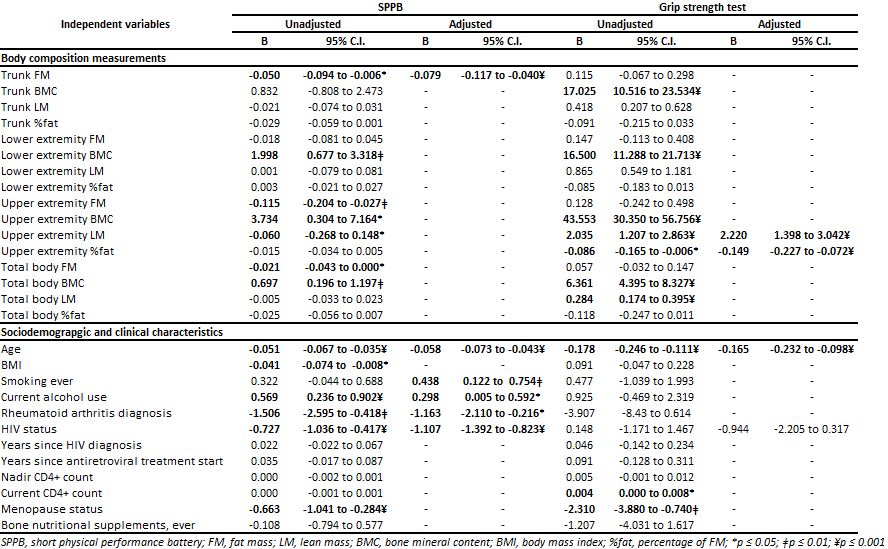Session Information
Session Type: Poster Session B
Session Time: 9:00AM-11:00AM
Background/Purpose: The musculoskeletal (MSK) system is significantly affected by HIV and its treatment. Changes in body composition can reflect important changes in bone and MSK health, particularly among populations at risk for developing fat redistribution syndromes, like HIV-positive women (HpW). Although more than half of HIV-infected population worldwide are women, there are limited data about characteristics of women aging with HIV in Latin American and the Caribbean (LAC). No studies from LAC have focused on the relationship between body composition changes and physical function among these individuals. We aimed to explore the scope of this problem among Peruvian women aging with HIV.
Methods: We enrolled HpW and HIV-negative women (HnW) ≥40 years of age receiving care at a large HIV clinic in Lima, Peru. Dual X-ray absorptiometry (DXA) was used to measure trunk and limb lean mass (LM) and fat mass (FM). Physical performance was assessed with the well-established Short Physical Performance Battery (SPPB) and physical strength with the grip strength test (GST) using a hand hydraulic dynamometer. We used linear regression to model associations between HIV status, body composition and physical test scores.
Results: 104 HpW and 212 HnW were enrolled with a mean age of 52.4±8.2 and 56.4±8.8 years (p< 0.001) and BMI of 26.4±5.1 and 27.6±4.1 kg/m2 (p=0.03), respectively. Among HpW, the mean years since HIV diagnosis was 11.8±6 and everyone was on antiretroviral treatment (9.9±5.3 years). Fat mass index (FMI) was 9.6±3 vs 10.9±2.7 kg/m2 (p< 0.001) between HpW and HnW, respectively. Overall mean SPPB score was 9.9 vs 10.8 between HpW and HnW, respectively (p< 0.001). Mean grip strength was 19.9±5.9 vs 19.8±5.4 kg (p=0.83) between HpW and HnW, respectively. In multivariate models adjusted by age and HIV status, increased trunk FM was independently associated with decreased SPPB score (p< 0.001), increased arm LM was independently associated with increased GST(p< 0.001) and increased arm %fat was independently associated with decreased GST (p< 0.001).
Conclusion: In this study, trunk FM and arm LM were independent predictors for the physical performance and function tests described, and HIV status was independently associated with SPPB score. Larger prospective studies are needed among PWH in LAC to help identify individuals at high risk for declines in physical function, and to inform prevention guidelines.
 Table 1: Overall SPPB Scores and Sub-scores and Grip Strength according to HIV status
Table 1: Overall SPPB Scores and Sub-scores and Grip Strength according to HIV status
 Table 2: Unadjusted and Adjusted Linear Regression for SPPB and Grip Strength
Table 2: Unadjusted and Adjusted Linear Regression for SPPB and Grip Strength
To cite this abstract in AMA style:
Cabrera D, Cornejo Ortega M, Pinedo Y, Garcia P, Hsieh E. Association of Regional Body Composition and Physical Function Using the Short Physical Performance Battery Among Peruvian Women with HIV [abstract]. Arthritis Rheumatol. 2020; 72 (suppl 10). https://acrabstracts.org/abstract/association-of-regional-body-composition-and-physical-function-using-the-short-physical-performance-battery-among-peruvian-women-with-hiv/. Accessed .« Back to ACR Convergence 2020
ACR Meeting Abstracts - https://acrabstracts.org/abstract/association-of-regional-body-composition-and-physical-function-using-the-short-physical-performance-battery-among-peruvian-women-with-hiv/
